Hammer Toes and Tool Box Names!
Today I am covering toe problems and foot pain
The toe deformity is often called a hammer toe because of the bent shape like a hammer. It causes problems in shoes from chilblains in cooler periods to corns after activity. Solving the problem can be assisted by a little more knowledge. David, a former clinician and podiatrist, takes you through some of the questions that you need to consider. Above all can you solve the problem yourself?
Six questions you might ask

- What is it?
- Why should I be concerned?
- How did this happen and why me?
- Is it serious and should I do something about it?
- Can I help myself?
- When do I need a professional?
I move from hammer toe humour in literature to defining what it is and tasking SIX questions. You diagrams and clinical photos to help guide your understanding. Some photos may be a bit gory! Then there is a bit about surgical consideration without the detail but enough to take you to the next stage.
Funny words

DJMcGee/Shutterstock
Anyone who first hears the word hammer in connection to the toe might well be mystified. The deformity derives it shape from a hammer.
Literature and by that I mean books, represent the hammer toe as comedy. Drew Morton (2017) in ‘Panel to Screen’ writes “…even in Hollywood grappling hand over hammer toe to grab the latest ‘hot’ comic release…
In Laughing Matters, Comic Timing (2012). “It is a grossly humorous object to be rankled alongside his useless feet beloved of the corn… the bunion, the hammer toe…” (Laura Salisbury writes in Samuel Beckett).
And best of all for being abstract,
Chelsea Handler My Horizontal Life (2007) “One of my best friends is Shoniqua. She is black. She’s six feet tall and has the ass of a medicine ball. I call her ‘hammer toes‘.”
To those with a toe deformity there can be little humour but misery
What does this tell you?
‘That people laugh at the bent toe is no laughing matter’ Author

An example of a hammer toe. The knuckle joint has pressure and this can be seen as the skin is red and thicker. The thickening is called callus (c/o Author: 2017).
What is it?
All the small toes have two joints, the big toe has one joint. If the toe is bent at one of these two joints it is called a fixed flexion deformity. The tool box analogy applies by suggesting the furthest joint is hammered and the joint near the toe is malted. Therefore a hammer toe and a mallet toe have different positions. See the diagrams below and the picture above.
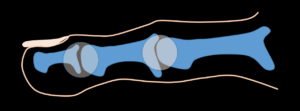
The toe is straight at both joints (C) 2020 Author

Hammer toe the deformity arises at A and pressure is seen at A & B locations. The tendon (yellow) is tight and shortened with time. (C) 2020 Author
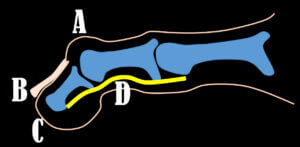
The mallet toe where the joint near the nail B arises. pressure again occurs over A and C. D is the tight tendon position maintaining the deformity (C) 2020 Author
Why should I be concerned?
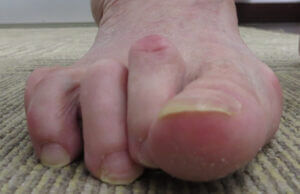
Three toes (2-4) are all flexed and therefore adopt a hammer toe deformity. Note toe 3 & 4 have more pressure on the ends and the edge of the 3rd toe is affected. Author (C) 2020
If the toe bends, pressure can develop around A-C. The nail may thicken if the end of the toe is squashed against the shoe. The skin thickens and form callus or it forms a deeper area of concentrated skin thickening called a corn. Conditions associated with mallet or hammer toes include chilblains, pressure ulcers, infections, blisters as well as corns and callus. The toe most commonly affected is the second toe. If you have a bunion this may be made worse because the second toe anatomy causes tensioning of the tendons shown in yellow. The three bones may be pushed out of alignment at the next joint along ( illustrated). The second toe in this photograph has lifted off the ground compared to the third toe which still lies on the ground.
The big toe only has a modest bunion but if this worsens the second toe will left upwards even further. Some deformities are so severe that they sit over the top of the big toe having rotated around.
How did this happen and why me?
It a few cases people are born with toe deformities but most develop problems at these joints later in life. In communities where povity is rife, and shoes are handed down, long feet and toes in short, small and tight shoes leave a permanent deformity as the tendons tighten. Those who wear no shoes fair better.
Damage through sports, work or home accidents can arise. The joint is damaged and stiffens sometime straight and sometimes bent.
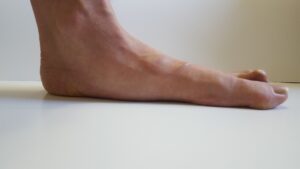
The second reason for hammer toes is foot shape and how the hind foot works. Paula/Shutterstock.com
Podiatrists believe that if tight shoes and socks are not to blame then look at the first toe. Is it stiff or deformed (bunion)? This causes the second toe to bend as part of a change in the way tendons work. A second reason relates to the shape of the foot and how it behaves under the ankle during walking. Some toe tendons are long and attach to muscles in the leg, while others are short and remain within the foot. These long and short tendons actually work together but if the hind foot rolls inwards, flattening the foot, or in the case of the opposite, makes a very high arch shape (cavus foot), then the toes buckle because one tendon pulls much harder.
By using an arch type support (orthosis) the tendon balance can be improved even if the arch shape does not change dramatically. However in patients where muscles are affected by nerve disease (neuromuscular) conditions then simple supports won’t assist to the same extent. If a foot has a well established toe deformity then due to the length of time this has existed the joints will have stiffened. A stiff joint that is bent cannot be put back without surgery. All that we can do is protect those areas that experience greatest pressure.
Is it serious and should I do something about it?
Toe deformities are not serious provided that the skin is not damaged. Additionally as long as the toes have not lost their ability to feel touch, pressure and hot and cold then the skin will cope. The more rigid that a toe becomes the greater the difficulty fitting shoes around the toe box. A stiff toe cap will run the skin.
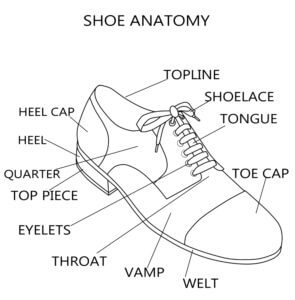
Giogiogo/Shutterstock
It is important to to make sure shoes fit across the tops of your toes and that pressure does not build up

Aksanku/Shutterstock
Can I help myself?

dizain/Shutterstock
Pain comes from pressure so the first thing is find out where that pressure is coming from. This can be from the top of the toe, the end of the toe or underneath. If this is not the case seek out more information. Here’s a case example below.
Is the toe infected? Swollen, hot, discharging of the toe may indicate an infection.
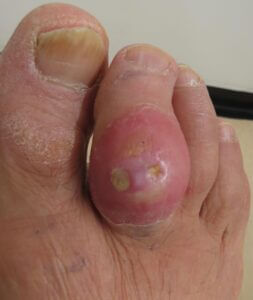
infected second toe (Author:2017)
In many cases a hole may leak a thick discharge. Dress with an antiseptic, remove pressure. Seek help if red streaks can be seen or the foot is red and swollen and hot. A toe as illustrated requires specialist attention. This turned out to have infected bone.
Does the toe have a chilblain? These are red, sometimes the colour appears dusky bluey-mauve over the skin. This NHS site has some good photos and information
Is the skin thicker and tender or does the skin have a blister? Check out my article on blisters. The method for managing blisters is similar for other parts of the foot but of course prevent infection.
You can use softening softening cream for a few days. DO Avoid sharp blades. Avoid over rubbing with a pumice stone as too much rubbing may make the toe bleed. Apply a finger dressing with a foam or silicone sleeve. Click to see an example of a silicone pad and sleeve. These are available to the public and work well to soften callus, assist with deeper corns but removing pressure. Do not wear anything that is tight around a toe at night or if use anything tight when the toe is swollen as above.
Does the skin have a dark area suggesting a deeper corn?
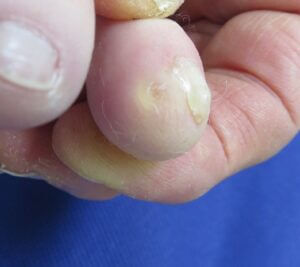
This is a corn formed because if pressure from the toe bone as a result of mallet toe deformity Author (C) 2020
Can I straighten my toe without surgery?
This is a reasonable question. There is little evidence knocking around on can we straighten toes. Two factors determine if this will work. How long has the problem been present. (1) If the deformity is stiff then no absolutely not, surgery is the only way to straighten a toe. (2) if you have not restrictions in shoes and the toe is flexible, meaning you can physically straighten the toe, then you have a chance. Lets talk PROPS or ‘toe props’.
 Do flips flops and similar designed sandals cause toe deformity? Many say this is the case. I have seen many people wear anything from this style to the Scholl type sandals without detrimental effect. If one or more lesser toes are bending then if your shoes are not too tight or short, your socks haven’t shrunk, then you could try toe props. There are plenty on the market and they work by lifting the toe so when you walk the tendon lengthens out. I have seen tight toes in children where I have had to operate and so a small procedure where the tendon is nicked (tenotomy) can sometime help and then use toe splints to stop the toe returning. The operation is not uncommon but always try toe props first. I have checked out a few YouTube videos. You can certainly use your favourite online site to buy a toe prop either washable plastic or chamois leather. In the video you can click, Rebecca Rushton an Australia podiatrist gives out a bit of advice in this 47 second clip (video). This is for blisters, which is fine, but gives you the idea. Silicone props moulded to the toes work well and probably are best fitted by a professional. Many videos do show you how to make props but first of all you have to be able to reach your feet!
Do flips flops and similar designed sandals cause toe deformity? Many say this is the case. I have seen many people wear anything from this style to the Scholl type sandals without detrimental effect. If one or more lesser toes are bending then if your shoes are not too tight or short, your socks haven’t shrunk, then you could try toe props. There are plenty on the market and they work by lifting the toe so when you walk the tendon lengthens out. I have seen tight toes in children where I have had to operate and so a small procedure where the tendon is nicked (tenotomy) can sometime help and then use toe splints to stop the toe returning. The operation is not uncommon but always try toe props first. I have checked out a few YouTube videos. You can certainly use your favourite online site to buy a toe prop either washable plastic or chamois leather. In the video you can click, Rebecca Rushton an Australia podiatrist gives out a bit of advice in this 47 second clip (video). This is for blisters, which is fine, but gives you the idea. Silicone props moulded to the toes work well and probably are best fitted by a professional. Many videos do show you how to make props but first of all you have to be able to reach your feet!
Do I need a professional?
It is important not to ignore a foot problem. If you have an underlying medical condition such as blood vessel disease and poor circulation please make an early appointment to see either your practice nurse or a podiatrist. Early assessment and protection of the skin from spreading infection is important. Where you do help yourself but there is no improvement within 48 hours again seek help. If you feel it is urgent then ring 111 if there is a delay in finding medical support. Try not to use the A&E department.
SURGERY

Shutterstock
- Remember, prevention is better than cure. This means finding the source of the problem, removing it and preventing it coming back.
- Do look at your shoes. They may not have caused the problem but they will make matters worse
- If you keep experiencing toe problem and your shoes are making life difficult then you can consider surgery. I have included a few sites that might be of value to answer questions on surgery.
- Surgery is indicated for frequent infections, recurrent ulcers and severe pain from corns. Surgery can be undertaken in toes without going to sleep and on the basis of go home the same day.
As far as further information on surgery I have selected a few sources although there are many more available
![]() Most information is several years old but a good deal of the information is valid. While the Medical news article is at the bottom of this list it does contain helpful information about hammer toes in general but does carry annoying adverts but don’t let that put you off. Many clinicians produce their own in-house fact sheets that are excellent.
Most information is several years old but a good deal of the information is valid. While the Medical news article is at the bottom of this list it does contain helpful information about hammer toes in general but does carry annoying adverts but don’t let that put you off. Many clinicians produce their own in-house fact sheets that are excellent.
- NHS fact sheet from podiatry UK Dept. North Tees
- Claw toes from FootEducation (USA)
- What to expect from a Canadian factsheet source
- Royal College of Podiatry (UK) source hammer toes
- Medical News Today article (2017)
Thank you for reading ‘Hammer Toe Sound as though it belongs to a Tool Box’ written by David R Tollafield May 2020.
![]()

Published by
Busypencilcase Reflective Communications
Est. 2015
![]()
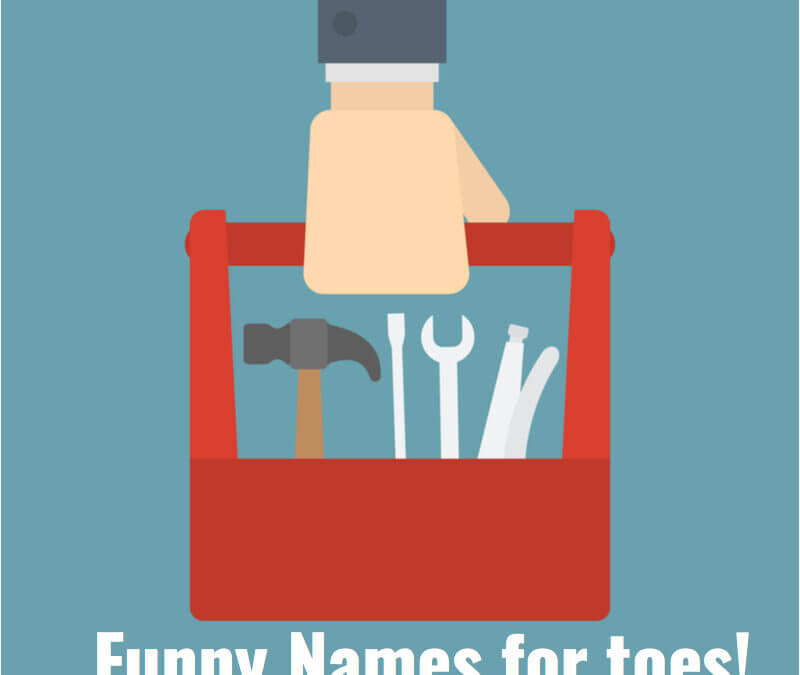
Recent Comments